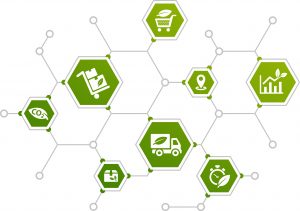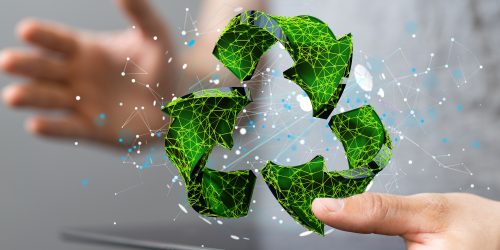5 steps to secure my sustainable supply

Guide: 5 steps to secure my sustainable supply
Collective awareness of the environmental impact of consumer habits has been growing in recent years. Companies are taking action by implementing more sustainable resource management solutions involving the use of water, renewable energy, raw materials, etc. On the front line, procurement managers are increasingly conscious of the challenges of sustainable development. According to the EcoVadis Sustainable Procurement Barometer 2021, 63% of them consider these objectives to be “very important”, compared to 25% in 2019. In the wake of this revolution in the world of procurement, the securing of sustainable supply chains has yet to be consolidated. Discover the 5 steps to follow to achieve this.
1 – Uniting staff around sustainable development
Achieving your Sustainable Development Goals (SDGs) is impossible without the support of your staff. To persuade them of the real added value of making this a priority, you also need to be personally committed. So, be sure to learn about effective sustainable procurement practices and regularly consult specialised websites.
The next step is to instill this environmentally responsible spirit in your employees. Using CSR team-building techniques is an excellent way to engage them. Through an action plan that is consistent with the business message, it is easier to arrive at a collective commitment.
Every employee in the company is involved in the sustainable supply chain, from purchasing new products or services to reducing waste. To raise awareness of the positive impact of high-quality sustainable supply, time must be taken to train staff and to explain to them the mechanics of procurement management. They need to be aware of the environmental, social, and economic benefits of such an approach. By being aware of all the issues, they will feel more involved and motivated to take action at their level. This is a key step towards building a sustainable supply chain on a solid foundation.
2 – Implementing the sustainable procurement strategy
Appointing sustainable development representatives enables the corporate strategy to be communicated to staff and suppliers. To coordinate action at each level of the supply chain, it may be appropriate to set up a special division. The members of this division will closely monitor the environmental impact of the company’s practices and avenues for improvement to reduce the cost of the green supply chain. Precisely identifying everyone’s role helps secure the sustainable supply chain while also increasing profitability.
To achieve the objectives of the management plan, appropriate procedures should be put in place. These measures will be most effective if they are designed in partnership with experts in sustainable development. This will provide guidelines that will lead to the adoption of responsible practices at every level of the supply chain.
This step requires that employees and suppliers understand the impact of these guidelines on the sustainable supply chain. They will thus ensure compliance with these environmentally responsible solutions over time.
3 – Turning suppliers into eco-partners
Sustainable procurement has transformed companies’ relationships with their suppliers. A common value links these two entities: the roll-out of their CSR policy. In this context, the international standard ISO 20400 was developed to address two issues:
- Certifying the implementation of a sustainable procurement strategy;
- Involving Tier 1 suppliers in this process.
The aim is to strengthen the social, ethical, and environmental performance of all parties. The criteria of price and deliverability of the product or service are no longer sufficient. The life-cycle cost and carbon footprint must now also be taken into account. It is therefore important to carefully select suppliers to ensure the reliability of the sustainable supply chain. Here are some tips on how to build a lasting partnership:
- Choose suppliers that share the same values as the company;
- Be clear about your expectations when defining the terms of the contract;
- Develop and monitor a joint action plan;
- Organise workshops and awareness campaigns together.
Good communication right from the call for tenders builds trust and credibility. Moreover, suppliers will be more inclined to get involved in a CSR approach if they see that the principals adopt an exemplary attitude throughout the partnership.
4 – Successfully planning your environmentally responsible management
In large businesses, end-to-end supply chain planning makes operations more efficient and sustainable. Careful planning of each step helps to identify any gaps in the chain. Internal risks from areas such as IT, human resources, and project management are the easiest to identify. On the other hand, it is more complicated to anticipate supplier risk. In order to secure a sustainable supply chain, it is necessary to ensure that suppliers comply with the CSR policy.
The use of modern digital technology offers real-time visibility despite the complexity of the sustainable supply chain. Modeling your management process using artificial intelligence (AI) is an essential performance driver for increasing the resilience of your supply chain. In this way, it is possible to reduce the environmental impact during the production, transport, and storage of goods. Likewise, geolocation makes it possible to optimise the routes taken by HGVs and thereby reduce CO2 emissions. WMS software, RFID chips, and 5G are also helping to improve the supply chain.
All of these digital solutions are useful tools for setting up a sustainable circular economy.
5 – Developing your sustainability policy
The integration of specific and measurable KPIs (Key Performance Indicators) helps companies to monitor their sustainability performance. The ISO 14031 standards, for example, include the following three indicators:
- Environmental Condition Indicators (ECIs);
- Management Performance Indicators (MPIs);
- Operational Performance Indicators (OPIs).
These performance indicators make it possible to identify which practices are effective and which are less so. Supplier dashboards can be useful for supplementing data. These enable companies to refine their strategy and secure their green supply chain.
Periodic identification of risks to the sustainable supply chain should be put in place. Depending on their criticality, specific actions must be taken to address the faults detected. This monitoring enables companies to keep an eye on the emergence of new risks and thereby maintain an optimal level of performance. With global warming and rising sea levels, the green supply chain must also be ready to adapt in the event of resource shortages. Favouring short circuits and recycling products reduces the risk of shortages. Furthermore, preparing a balanced management plan helps companies to deal with these exceptional situations.
As you can see, securing a sustainable supply chain is a team effort. In addition to the technical aspects, it is essential to gain the support of employees and suppliers. Improving environmental, social, and ethical performance must be a priority for everyone in the chain. Securing the green supply chain gives companies a competitive advantage.






